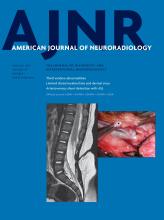Abstract
BACKGROUND AND PURPOSE: There is very limited data concerning utilization of flow diverters in children. Our aim is to report results for the treatment of complex intracranial aneurysms and carotid cavernous fistulas by using flow diverters in children.
MATERIALS AND METHODS: Retrospective review of children (17 years of age or younger) treated with flow diverters between May 2011 and July 2014 was performed. Clinical and laboratory data and angiographic findings were extracted. Seven patients (6 males, 1 female; mean age, 12.7 years; range, 3–16 years) were included. Two presented with posttraumatic fistulas. The remaining patients presented with traumatic aneurysms of the cavernous carotid artery or fusiform aneurysms of the distal vertebral artery, M1, or A2 segments. All patients were premedicated with clopidogrel (75 mg daily for patients with body weights of >45 kg, 37.5 mg daily for 1 small child with a body weight of <45 kg) and aspirin (300 mg daily for ≥45 kg, 100 mg daily for smaller children).
RESULTS: VerifyNow and Multiplate Analyzer values were higher than expected. No clinical complications were noted. Imaging performed at 7–52 months after the procedure (mean/median, 22.3/14 months) revealed occlusions of all aneurysms and fistulas. One patient had an asymptomatic occlusion of the parent artery; otherwise, no hemodynamically significant parent artery restenosis was observed. There were no clinically significant neurologic events during follow-up.
CONCLUSIONS: Although flow-diverter placement appears to be safe and effective on midterm follow-up in children, longer follow-up is critical. The current sizes of flow diverter devices and delivery systems cover the pediatric size range, obviating developing flow diverters specific to children.
ABBREVIATIONS:
- APT
- antiplatelet therapy
- CCF
- carotid cavernous fistula
- PRU
- P2Y12 receptor reaction unit
- © 2017 by American Journal of Neuroradiology
Indicates open access to non-subscribers at www.ajnr.org












